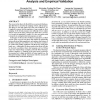151 search results - page 9 / 31 » Seeding Genetic Programming Populations |
SOCO
2010
Springer
13 years 2 months ago
2010
Springer
In this paper, a diversity generating mechanism is proposed for an Evolutionary Programming (EP) algorithm that determines the basic structure of Multilayer Perceptron classifiers ...
BMCBI
2008
13 years 7 months ago
2008
Background: FREGENE simulates sequence-level data over large genomic regions in large populations. Because, unlike coalescent simulators, it works forwards through time, it allows...
BMCBI
2007
13 years 7 months ago
2007
Background: Metagenomic analyses of microbial communities that are comprehensive enough to provide multiple samples of most loci in the genomes of the dominant organism types will...
GECCO
2008
Springer
13 years 8 months ago
2008
Springer
The crossover bias theory for bloat [18] is a recent result which predicts that bloat is caused by the sampling of short, unfit programs. This theory is clear and simple, but it ...
GECCO
2005
Springer
14 years 1 months ago
2005
Springer
Tournament selection is the most frequently used form of selection in genetic programming (GP). Tournament selection chooses individuals uniformly at random from the population. A...


